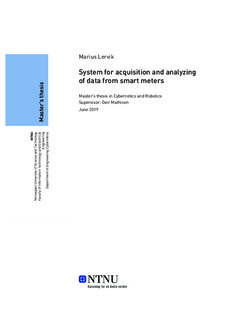| dc.contributor.advisor | Mathisen, Geir | |
| dc.contributor.author | Lervik, Marius | |
| dc.date.accessioned | 2019-10-31T15:11:56Z | |
| dc.date.issued | 2019 | |
| dc.identifier | no.ntnu:inspera:35771502:18225137 | |
| dc.identifier.uri | http://hdl.handle.net/11250/2625734 | |
| dc.description.abstract | Den pågående moderniseringen av strømnettet i Norge har ført til installasjon av smarte strømmålere (AMS) for alle strømkunder. AMS-målerne sender automatisk data til nettselskapet om strømforbruket til kunden. Personlig data er blitt gjort tilgjengelig for kunden gjennom en port på framsiden av meterne.
To systemer for å samle inn personlig data fra AMS-målere har blitt designet og implementert i denne oppgaven. Begge systemene bruker Wi-Fi til å sende data til en skytjeneste for videre prosessering og lagring. Flere enheter ble produsert av et av systemene. Disse enhetene ble brukt til å samle inn data fra flere kilder.
Datamengden som ble samlet inn ga ikke et godt nok grunnlag til å utføre en nøye analyse og tilstandsestimering av distribusjonsnettet, men en signifikant trend i variasjonen av spenningsverdier ble oppdaget. Trenden viste at spenningsnivået var konsekvent høyest på natta og lavest på morgenen og kvelden. Disse tidspunktene tilsvarer tidene det er minst og størst belastning på distribusjonsnettet. | |
| dc.description.abstract | The ongoing modernization of the Norwegian electricity grid has led to the installation of smart electricity meters (AMS) for all power consumers. The AMS meters automatically send data concerning power usage directly to the distribution network operator, while personal data for the consumer has been made available through a port on the front of the meters.
In this thesis, two embedded systems for the acquisition of consumer data from AMS meters have been designed and implemented. Both systems use Wi-Fi to transfer measurement data to a cloud service for further processing and storage. Multiple units of one of the system designs were produced and successfully used for data collection from multiple sources.
Although not enough data were collected to perform a thorough analysis and state estimation of the distribution network, a significant trend in the variation in voltage values was found. The trend showed that voltage values were consistently highest during the night and lowest during the morning and evening, which corresponds to the times with the lowest and highest network load. | |
| dc.language | eng | |
| dc.publisher | NTNU | |
| dc.title | System for acquisition and analyzing of data from smart meters | |
| dc.type | Master thesis | |
